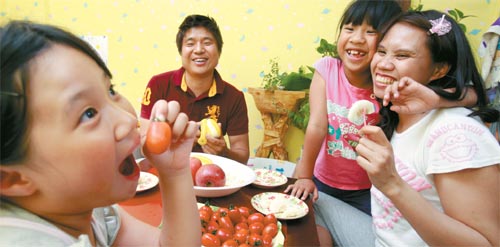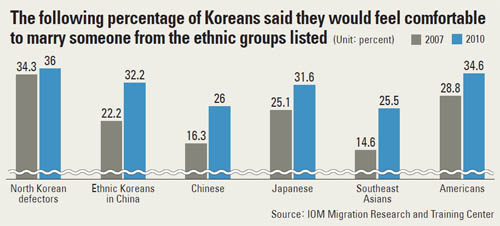Finally, embracing immigrants

The family of Angie G. Escobin, right, is all smiles as Escobin’s eldest daughter Yim Ha-ni, left, amuses the family at home in Goyang, Gyeonggi, on Thursday. Escobin says she feels more welcome in Korea than when she first moved here. By Lee Chan-weon
Angie G. Escobin, a Filipina who came to Korea in 2001 to marry a Korean in Goyang, Gyeonggi, said she feels Koreans are opening up to foreigners more than ever before, especially to marriage immigrants.
“Just three years ago, my neighbors thought I married a Korean man for money because the Philippines is a poor country, and I was very offended by that,” Escobin said at the time.
She was treated as an outsider, and not a very welcome one at that.
But times have changed in Korea, experts say. A new survey shows that Koreans’ attitude toward foreigners has improved dramatically, and quickly.
“Such prejudices are gone,” Escobin said, echoing that opinion. “My two elementary school children don’t get teased about their skin color because many of their classmates are also from multicultural families. The headmaster even created a meeting for mothers of multicultural families. He even phones us to report on our children’s progress in the class on a regular basis. He told me that my daughter, Ha-yeon, is doing well.”
Escobin said she feels grateful that Korean people treat her children well.
Escobin, who occasionally gives presentations in Korean on Philippine culture to raise awareness about multiethnicity, said she was able to pick up Korean quickly, thanks to an elderly woman in her neighborhood.
Learning Korean has enabled Escobin to work as a translator in Goyang to help narrow the language barriers between Filipino and Korean couples.
“When I was a newlywed, there was no multicultural family support center that offered a Korean language class,” she said. “I always had to rely on a Filipino-Korean dictionary to communicate with my husband.”
Escobin studied Korean by watching television shows and overhearing elderly people’s conversations in a neighborhood park.
“Then I met this granny at the park seven years ago,” she said. “Though other old women didn’t speak a word to a foreigner, she was different. She sat next to me and told me that a married couple lives happily forever if they overcome struggles that come once every three years for nine years. She even gave me a tip that I should warmly greet my husband and wash my husband’s feet when he’s home. In respect of her advice, I still wash my husband’s feet. She was like my maternal grandmother and best friend. I feel lonely now because she passed away last year. I really miss her.”
In fact, Escobin is not the only one who feels the changes in society.
A nationwide survey conducted by the IOM Migration Research and Training Centre in 2010 suggested Koreans are more open and tolerant toward immigrants than previously projected. The survey examined Koreans’ notions of national identity and their attitude toward immigrants and foreigners by polling 1,576 adult Koreans from July to September last year. The results of the survey are set to be published this year.
According to the survey, obtained exclusively by the Korea JoongAng Daily, 81.6 percent of the 1,576 Koreans who took the survey responded that children born in Korea of parents who are not Korean citizens should have the right to become Korean citizens, an 11.2 percentage point increase from a 2003 survey.

“Some would downplay the numerical change because they think a ten-something percent increase is not a big deal,” said Chung Ki-seon, chief researcher of the IOM Migration Research and Training Centre. “But a ten-something percent increase in people’s notion and attitude within seven years is a huge change, given that it normally takes decades for people to change their values.”
More and more women in developing economies from Southeast Asia are migrating to Korea for marriage as a way to improve their lives and this trend has created an increasing number of multiethnic families, in which the two parents have different cultural and ethnic backgrounds.
According to government statistics, there are 181,671 marriage immigrants living in Korea as of May and 89 percent of them are women. Ethnic Koreans in China, Chinese, Vietnamese, Filipino and Japanese are top ethnic groups who marry Koreans.
As multiethnic families generally face language barriers as well as various other problems, the government has established multiethnic family support centers across the country. There are 253 such centers.
Jang Heun-seong, chief of the Gumi Multicultural Family Support Center, which assists multiethnic families in North Gyeongsang, said the change in the public’s perception of foreigners in such a short period of time was possibly due to the influx of female marriage immigrants from Southeast Asia.
“More people are open to foreigners not because of the increase in the number of migrant workers,” Jang said. “This wouldn’t happen without marriage immigrants. Unlike migrant workers who go back to their countries after working at factories for a few years, marriage immigrants become someone’s daughter-in-law and sister-in-law.
“When a baby is born, it means a marriage immigrant gives birth to someone’s grandson and nephew. The baby becomes a blood relative of a Korean family.
“Koreans’ attitudes toward immigrants and foreigners changed not because they wanted to. They accept marriage immigrants as their family because they can’t deny the baby.”
The center offers courses for marriage immigrants, including Korean language, yoga, cooking, computer and driving license prep classes.
“I felt the changes after the government started running multicultural family support centers,” Jang said. “When I called husbands and urged them to help their wives learn Korean just eight years ago, they suspected I was a pseudo intellectual and hung up because there were no multicultural family support centers at that time.”
Jang said many husbands didn’t want their wives to study Korean because they wanted to avoid a future situation where wives would talk back to their authoritarian husbands.
“Now many husbands walk into the center with their wives to register for courses,” she said.
The Gumi Multicultural Family Support Center hired nine marriage immigrants from Vietnam, China and Indonesia as full-time and part-time staff members.
Do Thi Bich Dung, a 29-year-old Vietnamese woman, is a case in point.
Do, who first came to Korea as an industrial trainee at a textile factory in North Gyeongsang in 2003, had no intention of settling down here until she met her husband through her dormitory supervisor. The couple now has a 5-year-old son, Si-hyeon.
Do, who has been working as a full-time Vietnamese-Korean translator for the Gumi center for the past three years, said she feels more Koreans including her in-laws and husband are more now open to her.
“Before we got married, my husband and I went to see his parents to get their approval, but my father-in-law wasn’t happy about me,” she said. “When the family gathered at my father-in-law’s house for the Lunar New Year holiday two years ago, he gave a 10,000 won bill ($9.20) to my sisters-in-law and he skipped me. When my mother-in-law insisted that he give me 10,000 won, he refused and shouted, ‘She’s wolnam! [Korean word for Vietnamese].’ But things have changed a lot and now he’s a big fan of me.”
Do, who is now fluent in Korean, confessed that she hesitated to speak her native language with her Vietnamese friends when they were out in public with Koreans.
“When I go to the market or walk on the streets, people stare at me because I look different,” she said. “When I was with my friends, we were shy about talking in Vietnamese because we didn’t like being stared at by pedestrians. We spoke in Vietnamese only when there were no Koreans around us. But now, we chat freely in Vietnamese in public because people have begun to see that speaking Vietnamese is a valuable skill just the same as a bilingual person who speaks Korean and English.”
While more Koreans are open to becoming colleagues, neighbors and friends with foreigners and marriage immigrants, the survey suggested Korea still has a long way to go to accept foreigners, as many are still conservative about international marriage.
The survey asked respondents about international marriage preferences. Of 1,576 respondents, 36 percent said they prefer to marry North Korean defectors and 34.6 percent said they want to marry Americans. Following Americans are ethnic Koreans from China (32.2 percent), Japanese (31.6 percent), Chinese (26 percent), and Southeast Asians (25.5 percent).
Although Southeast Asians are the least favored ethnic group that Koreans want to marry, according to the survey, experts note that 25.5 percent of respondents supported the idea in 2010, a 10.9 percent increase from 14.6 percent in the 2007 survey, trailing behind the Chinese.
“I do feel changes in the way Koreans treat foreigners, but the rate at which Koreans marry Southeast Asians is still low,” said Sukatin Choi, a 35-year-old naturalized Korean citizen from Indonesia who lives in Goyang. “This figure reflects the harsh reality that we still aren’t fully recognized in Korean society. We, I mean the government and us, must find ways to raise the figure.
Jang, of the Gumi center, echoed this by saying: “Koreans say it’s OK to be friends of Southeast Asians in the survey, but they don’t want to marry them and become a family.”
By Kim Mi-ju [mijukim@joongang.co.kr]










with the Korea JoongAng Daily
To write comments, please log in to one of the accounts.
Standards Board Policy (0/250자)